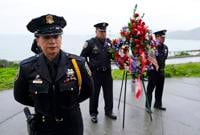FOCUS ON HISTORY - Alton R. Swann, born in Schenectady, moved to Gloversville, went to high school and business school there and became an accountant at Schenectady General Electric.
Drafted by the Army in May 1941, Swann was serving at Clark Air Base in the Philippines with the 803rd Engineer Battalion.
The day after the surprise attack on Pearl Harbor in 1941, a Japanese bombing attack December 8 resulted in destruction of Clark Field. Swann’s 803rd battalion was decimated in the battle for Bataan. After being moved to the island fortress of Corregidor, Swann was captured.
He survived a death march, three years of prison in the Philippines and Japan including a trip to Japan aboard a "hell" ship, the Noto Maru.
In Japan he was used as slave labor. Liberated after the Japanese surrender, he was aboard a hospital ship when he wrote his fiancé, Glendean Brooks in Gloversville, asking if she was still waiting for him.
She was. Swann married Brooks at the Gloversville Methodist Church parsonage Thanksgiving afternoon, 1945. Swann went back to work at GE, was transferred to New England and lived many years in Monroe, Connecticut.
James V. Hogg from Amsterdam was on a Navy ship somewhere in the Pacific when the Japanese attacked Pearl Harbor.
His niece Karen terHaar said, “In the months after Pearl Harbor, many ships in the area were ordered to maintain radio silence. The families of crew members did not know if their fathers, sons or brothers were dead or alive.”
Hogg’s parents, Frank and Mildred Hogg, were living on Grant Avenue in Amsterdam.
TerHaar wrote, “About four months after Pearl Harbor, Mom was sitting on the front porch when she heard the postman’s voice. She looked up and saw him running down the sidewalk. He was waving a letter and yelling, ‘Jimmy’s alive! Jimmy’s alive!’”
James Hogg became a Lieutenant Commander in the Navy and married a woman from Australia. He later lived in California.
An Amsterdam soldier died in the Japanese attack on Pearl Harbor 82 years ago. William E. Hasenfuss, Jr. came from a family of nine on Northampton Road.
Hasenfuss had flown planes at an air field in Perth before enlisting in the Army in 1939. He died when Japanese airplanes shot up the B-24 bomber Hasenfuss and his ground crew were working on at Hickam Air Field in Hawaii.
His mother, Frieda, Amsterdam’s first World War II Gold Star Mother, christened the light cruiser U.S.S. Amsterdam in 1944 at Newport News, Virginia.
“I was thinking of William when I smashed that bottle.” she said after the vessel slid into the James River.
A model of USS Amsterdam was handmade by the late Albert M. Swager of Pennsylvania, a former crewman, who donated it to Amsterdam’s Walter Elwood Museum. Volunteers are working on an exhibit.
The movie “South of Tahiti,” playing at the Strand Theatre on East Main Street in Amsterdam, was interrupted Sunday afternoon December 7, 1941 when the news broke that the Japanese had bombed Pearl Harbor. Radio coverage was piped into the theater and dazed patrons left the building.
George A. Tralka, 15, was at his family’s James Street home in Amsterdam when he heard about the attack on the radio. At first Tralka thought Pearl Harbor was in Alaska.
The next day as Tralka delivered the Schenectady Gazette he heard President Roosevelt’s “day of infamy” speech on the radio when at Reid Hill Pharmacy.
“It was a solemn moment in the drug store,” Tralka wrote in his memoir, “Diary of a Replacement Soldier.” Tralka survived the war and became a physician in the Washington, D.C. area.









